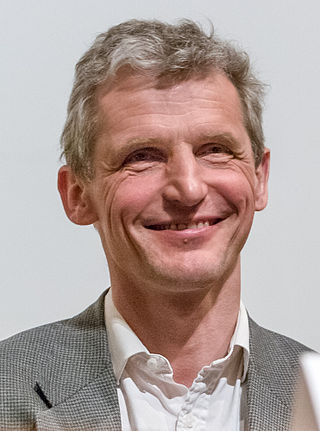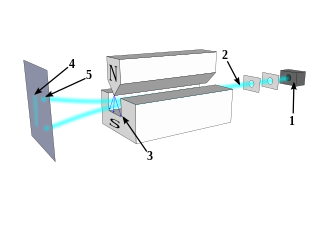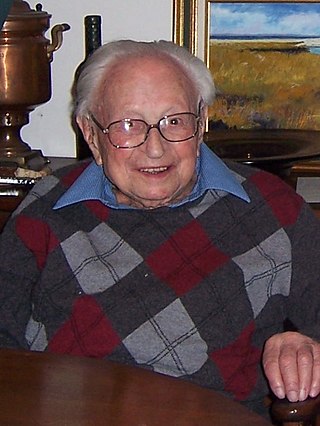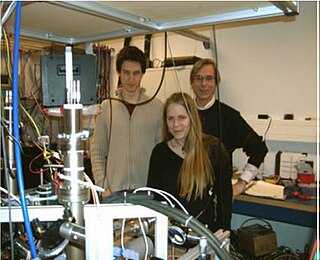Atomic physics is the field of physics that studies atoms as an isolated system of electrons and an atomic nucleus. Atomic physics typically refers to the study of atomic structure and the interaction between atoms. It is primarily concerned with the way in which electrons are arranged around the nucleus and the processes by which these arrangements change. This comprises ions, neutral atoms and, unless otherwise stated, it can be assumed that the term atom includes ions.

In condensed matter physics, a Bose–Einstein condensate (BEC) is a state of matter that is typically formed when a gas of bosons at very low densities is cooled to temperatures very close to absolute zero, i.e., 0 K. Under such conditions, a large fraction of bosons occupy the lowest quantum state, at which microscopic quantum-mechanical phenomena, particularly wavefunction interference, become apparent macroscopically. More generally, condensation refers to the appearance of macroscopic occupation of one or several states: for example, in BCS theory, a superconductor is a condensate of Cooper pairs. As such, condensation can be associated with phase transition, and the macroscopic occupation of the state is the order parameter.

Isidor Isaac Rabi was an American physicist who received the Nobel Prize in Physics in 1944 for his discovery of nuclear magnetic resonance, which is used in magnetic resonance imaging. He was also one of the first scientists in the United States to work on the cavity magnetron, which is used in microwave radar and microwave ovens.

John Hasbrouck Van Vleck was an American physicist and mathematician. He was co-awarded the Nobel Prize in Physics in 1977, for his contributions to the understanding of the behavior of electronic magnetism in solids.

Norman Foster Ramsey Jr. was an American physicist who was awarded the 1989 Nobel Prize in Physics for the invention of the separated oscillatory field method, which had important applications in the construction of atomic clocks. A physics professor at Harvard University for most of his career, Ramsey also held several posts with such government and international agencies as NATO and the United States Atomic Energy Commission. Among his other accomplishments are helping to found the United States Department of Energy's Brookhaven National Laboratory and Fermilab.

Wolfgang Ketterle is a German physicist and professor of physics at the Massachusetts Institute of Technology (MIT). His research has focused on experiments that trap and cool atoms to temperatures close to absolute zero, and he led one of the first groups to realize Bose–Einstein condensation in these systems in 1995. For this achievement, as well as early fundamental studies of condensates, he was awarded the Nobel Prize in Physics in 2001, together with Eric Allin Cornell and Carl Wieman.

Jerome Isaac Friedman is an American physicist. He is institute professor and professor of physics, emeritus, at the Massachusetts Institute of Technology. He won the 1990 Nobel Prize in Physics along with Henry Kendall and Richard Taylor, "for their pioneering investigations concerning deep inelastic scattering of electrons on protons and bound neutrons, which have been of essential importance for the development of the quark model in particle physics.", work which showed an internal structure for protons later known to be quarks. Friedman sits on the board of sponsors of the Bulletin of the Atomic Scientists.

In quantum physics, the Stern–Gerlach experiment demonstrated that the spatial orientation of angular momentum is quantized. Thus an atomic-scale system was shown to have intrinsically quantum properties. In the original experiment, silver atoms were sent through a spatially-varying magnetic field, which deflected them before they struck a detector screen, such as a glass slide. Particles with non-zero magnetic moment were deflected, owing to the magnetic field gradient, from a straight path. The screen revealed discrete points of accumulation, rather than a continuous distribution, owing to their quantized spin. Historically, this experiment was decisive in convincing physicists of the reality of angular-momentum quantization in all atomic-scale systems.

Chih-Kung Jen was a Chinese physicist who emigrated to the U.S. and participated in some of the 20th century's major scientific, political and social developments in both the United States and China.
Robert J. Kolenkow was an American physicist and teacher. He is best known for being the coauthor, along with Daniel Kleppner, of a popular undergraduate physics textbook, An Introduction to Mechanics.
David Edward Pritchard is a professor at the Massachusetts Institute of Technology (MIT) who specializes in atomic physics and educational research.

László Tisza was a Hungarian-born American physicist who was Professor of Physics Emeritus at MIT. He was a colleague of famed physicists Edward Teller, Lev Landau and Fritz London, and initiated the two-fluid theory of liquid helium.
The Davisson–Germer Prize in Atomic or Surface Physics is an annual prize that has been awarded by the American Physical Society since 1965. The recipient is chosen for "outstanding work in atomic physics or surface physics". The prize is named after Clinton Davisson and Lester Germer, who first measured electron diffraction, and as of 2007 it is valued at $5,000.

Jerrold Reinach Zacharias was an American physicist and institute professor at the Massachusetts Institute of Technology, as well as an education reformer. His scientific work was in the area of nuclear physics.

Joannes Theodorus Maria (Jook) Walraven is a Dutch experimental physicist at the Van der Waals-Zeeman Institute for experimental physics at the University of Amsterdam. From 1967 he studied physics at the University of Amsterdam. Both his doctoral research and PhD research was with Isaac Silvera, on the subject of Bose-Einstein Condensation. Because of the difficulty of his research subject, his promotion took six years instead of four. The aim of his PhD research was to make a gas of atomic hydrogen, which could become the world's first quantum gas. This might then be a suitable candidate for a Bose-Einstein Condensate (BEC).
Thomas Greytak is the Lester Wolfe Professor of Physics, emeritus, at the Massachusetts Institute of Technology. His areas of research include experimental low temperature condensed matter physics and superfluid systems. Currently, he is working with Daniel Kleppner on research concerning ultra cooled atomic hydrogen.

Julia K. Steinberger is Professor of Ecological Economics at the University of Lausanne. She studies the relationships between the use of resources and performance of societies. She is an author of the Intergovernmental Panel on Climate Change (IPCC) 6th Assessment Report, contributing to the report's discussion of climate change mitigation pathways.
Robley Dunglison Evans was an American nuclear physicist and pioneer of nuclear medicine. He was the president of the Health Physics Society in 1972–1973.

An Introduction to Mechanics, commonly referred to as Kleppner and Kolenkow, is an undergraduate level textbook on classical mechanics coauthored by physicists Daniel Kleppner and Robert J. Kolenkow. It originated as the textbook for a one-semester mechanics course at the Massachusetts Institute of Technology, where both Kleppner and Kolenkow taught, intended to go deeper than an ordinary first year course. Since its introduction, it has expanded its reach to other universities to become one of the most popular mechanics textbooks.











